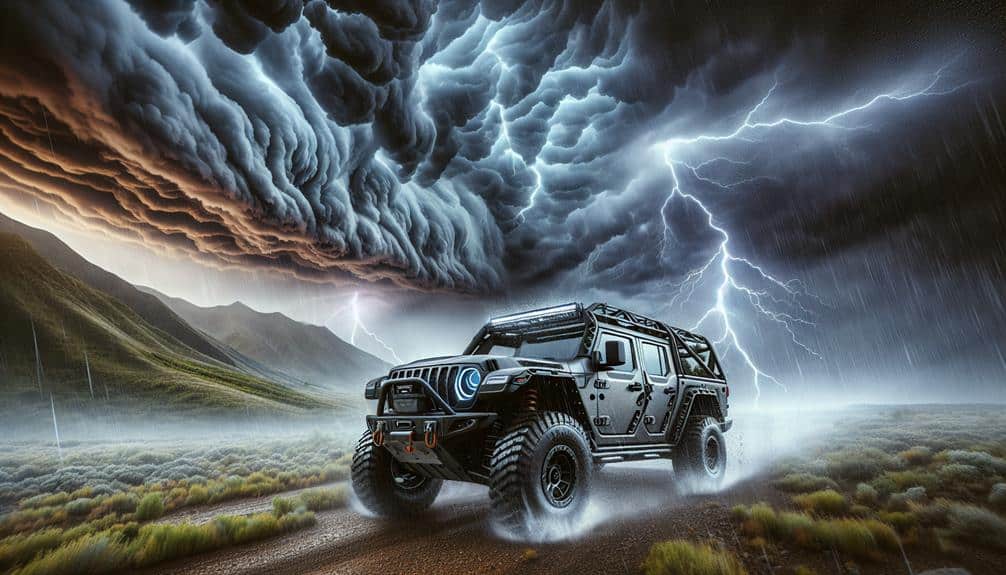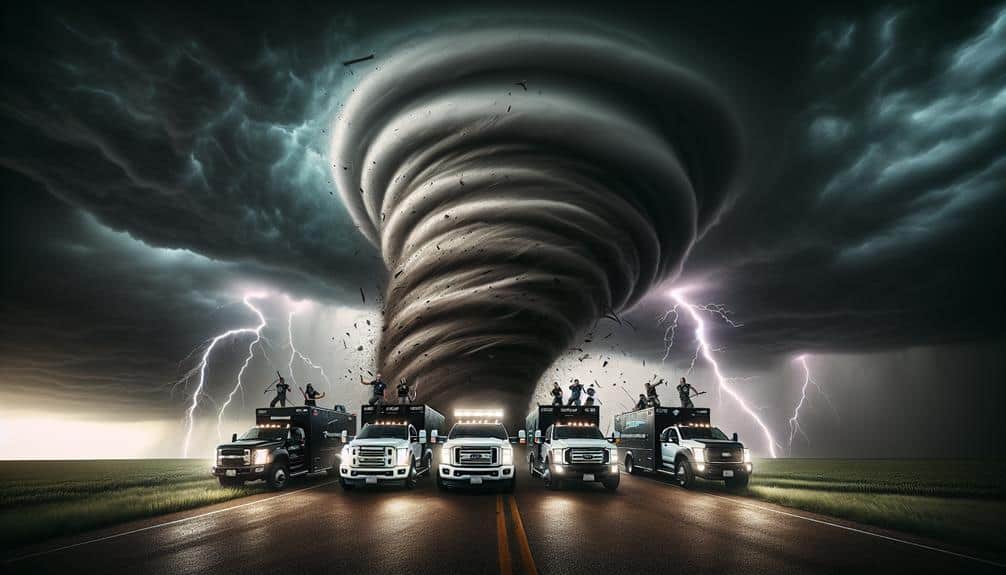We must prioritize safety when storm chasing by selecting reputable tour operators who adhere to strict safety protocols and possess relevant certifications. Utilizing live radar imagery and forecast models is vital for tracking storm systems. Sturdy clothing, dependable communication tools, and thorough first aid kits are essential gear. Having solid communication and emergency plans, including designated protocols and risk assessments, reduces potential hazards. Our vehicles should feature advanced safety technology and be meticulously maintained. Continuous access to high-definition meteorological data ensures we stay informed. Understanding these strategies greatly improves our safety and preparedness, making it important to delve into more details.
Key Points
- Verify the tour operator's safety protocols, emergency plans, and certifications from recognized meteorological societies.
- Wear layered, waterproof, and windproof clothing, and sturdy boots with ankle support for weather protection.
- Carry satellite phones and high-range walkie talkies for reliable communication in remote areas.
- Keep an emergency medical kit with antiseptic wipes, bandages, pain relievers, and a CPR face shield.
Choosing a Reputable Tour Operator
Selecting a reputable tour operator requires us to carefully evaluate their safety records, certifications, and customer reviews. We must dive deep into tour operator research to guarantee our adventure is both thrilling and secure.
First, we should examine the operator's safety protocols. Are they following the industry standards? Do they have a strong emergency response plan? These factors are crucial for our safety.
Next, we need to verify certifications. Legitimate storm chasing tour operators often hold certifications from recognized meteorological societies or safety organizations. These certifications indicate adherence to established safety practices and a commitment to professional standards.
Customer reviews are another essential source of information. By analyzing feedback from previous participants, we can gauge the operator's reliability and service quality. Look for patterns in the reviews—consistent praise for safety measures and knowledgeable guides can confirm our choice. Conversely, recurrent complaints about safety or professionalism should raise red flags.
In conducting this thorough tour operator research, we empower ourselves with the knowledge to make an informed decision. This approach not only maximizes our adventure but also guarantees we experience the freedom of storm chasing with peace of mind.
Understanding Weather Forecasts
To safely navigate our storm chasing adventure, understanding weather forecasts is essential for making informed decisions based on real-time data and meteorological patterns. By grasping the intricacies of storm patterns and meteorology, we can better predict the behavior of severe weather systems and make educated choices about when and where to chase.
Modern tracking technologies enhance our ability to stay updated with the latest developments. We should constantly monitor weather alerts and updates from reputable sources, ensuring we're always aware of any sudden changes in storm intensity or direction.
Here's a breakdown of key elements to watch:
- Radar Imagery: Provides real-time visualization of storm movement and intensity.
- Satellite Data: Offers a broader view of weather systems, essential for tracking developing storms.
- Forecast Models: Predict potential storm paths and evolution based on current data.
- Severe Weather Alerts: Issued by meteorological agencies, they're essential for staying ahead of dangerous conditions.
Essential Safety Gear
As storm chasers, we must prioritize vital safety gear to mitigate risks. Sturdy clothing with high wind resistance, dependable communication tools like satellite phones, and thorough emergency medical supplies are essential.
Data shows that preparedness markedly reduces injury rates during storm chasing activities.
Durable Clothing Choices
When gearing up for storm chasing, we need durable clothing that can withstand extreme weather conditions and protect us from potential hazards. It's crucial to choose gear that offers both functionality and protection. The right clothing can make a significant difference in our safety and comfort during these high-adventure pursuits. Here's what we should consider:
- Layering options: Layering is pivotal for regulating body temperature. Start with a moisture-wicking base layer, followed by an insulating mid-layer, and finish with a waterproof and windproof outer layer.
- Waterproof gear: Storm environments are often accompanied by heavy rainfall. Waterproof gear, including jackets and pants, keeps us dry and prevents hypothermia.
- Windproof jackets: High winds can be both cold and forceful. Windproof jackets are designed to block these gusts, offering both warmth and protection.
- Sturdy boots: The terrain can be unpredictable, from muddy fields to rocky outcrops. Sturdy boots with good ankle support and non-slip soles are vital for safe navigation.
Reliable Communication Tools
Effective storm chasing demands reliable communication tools to safeguard our safety and coordination in unpredictable weather conditions. Satellite phones are indispensable for maintaining contact when cell towers fail or are out of range. These devices utilize satellites orbiting the Earth, guaranteeing connectivity even in the most remote areas. It's essential we carry them to relay our position and receive updates on approaching storms, allowing us to adapt our route dynamically.
Walkie talkies provide another layer of communication, especially within our team. Unlike satellite phones, they operate on radio frequencies, offering instant, real-time communication without the need for a network. In the chaos of severe weather, a quick and clear exchange of information can make all the difference. High-end models with extended range and weather-resistant features secure we remain connected, regardless of the conditions.
Data from the National Weather Service indicates that rapid information sharing can reduce risk by up to 40%. By integrating satellite phones and walkie talkies into our gear, we enhance our situational awareness and response capabilities. This secures we can pursue our passion for storm chasing while maintaining the highest safety standards.
Emergency Medical Supplies
Equipping ourselves with an extensive first aid kit is crucial for addressing potential injuries and medical emergencies during storm chasing expeditions. Having a well-prepared kit ensures we can handle emergencies immediately, potentially preventing minor issues from escalating.
In our first aid kit, we should include items that address a variety of scenarios:
- Antiseptic wipes and ointments: To clean and disinfect wounds, reducing the risk of infection.
- Bandages and dressings: For controlling bleeding and protecting injuries.
- Pain relievers and anti-inflammatories: Essential for managing pain and discomfort.
- Personal medications: Guaranteeing proper medication management for any pre-existing conditions.
Data from emergency medical guidelines indicate that quick access to these supplies can greatly improve outcomes in crisis situations. Our sense of freedom on these exhilarating tours is grounded in the confidence that we're prepared for any medical emergency.
Moreover, maintaining an organized and easily accessible kit enables us to react swiftly, optimizing our response time.
Let's embrace the thrill of storm chasing with the peace of mind that comes from being thoroughly prepared with essential first aid and medication management tools.
Communication and Emergency Plans
Clear communication and robust emergency plans are critical components that safeguard our safety during storm chasing tours. We must establish clear communication protocols before setting out. This includes designating primary and secondary communication channels, such as two-way radios and satellite phones, to guarantee we remain connected even in remote areas. We also need to store a list of emergency contacts, including local authorities, medical facilities, and weather service agencies, in an easily accessible format.
In terms of emergency plans, we should conduct a thorough risk assessment for each chase. This involves analyzing weather models, storm trajectories, and potential hazards. By doing this, we can create contingency plans for various scenarios, such as encountering tornadoes, flash floods, or severe wind events. It's essential that every team member is familiar with these plans and understands their role in executing them.
Additionally, regular drills and simulations will help us respond effectively in real emergencies. We need to practice swift evacuation procedures and establish safe rendezvous points. Constantly reviewing and updating our communication protocols and emergency contacts safeguards we're always prepared.
Together, these measures enhance our freedom to chase storms safely and responsibly.
Vehicle Safety Features

Our storm chasing vehicles must be equipped with advanced safety features to guarantee we withstand extreme weather conditions and navigate challenging terrains. These features not only enhance our safety but also assure our ability to enjoy the thrill of storm chasing with peace of mind.
First, let's emphasize the importance of seatbelts. Properly worn seatbelts drastically reduce the risk of injury during sudden stops or collisions, a critical factor considering our high-speed chases and unpredictable weather conditions.
Crash avoidance systems are also indispensable. These systems use radar and cameras to detect potential collisions and can automatically engage braking mechanisms to prevent accidents.
Regular vehicle check-ups are non-negotiable. Ensuring our tires, brakes, and engine systems are in top condition minimizes the risk of mechanical failure during a chase. Additionally, our vehicles must have clearly marked and easily accessible emergency exits to facilitate quick evacuations if necessary.
To summarize, our vehicle safety features include:
- Advanced seatbelt systems
- Crash avoidance technology
- Regular vehicle check-ups
- Easily accessible emergency exits
Staying Informed During Tours
Staying informed during tours demands real-time access to meteorological data and continuous communication with weather monitoring stations. We rely on cutting-edge technology to receive frequent weather updates, guaranteeing that we're always aware of the latest storm developments. High-resolution radar, satellite imagery, and Doppler data are indispensable tools in our arsenal, enabling us to track storm cells with precision and adjust our routes accordingly.
Effective tour guide communication is essential. Our guides are in constant contact with each other and with meteorological experts, relaying important information about storm trajectories and potential hazards. This collaboration allows us to implement safety protocols effectively and make timely decisions to avoid high-risk areas.
Emergency procedures are always in place. We conduct briefings before each tour, outlining specific actions to take if conditions suddenly worsen. GPS systems and mobile weather apps are used to maintain our situational awareness, providing real-time data that can be acted upon immediately.
Frequently Asked Questions
What Should I Pack for a Storm Chasing Tour?
When packing essentials for a storm chasing tour, we need to include emergency supplies, appropriate clothing, and weather gear. Data-driven choices like moisture-wicking fabrics, waterproof jackets, and first-aid kits guarantee we're prepared for unpredictable conditions.
Are Meals Provided During Storm Chasing Tours?
Meals aren't typically provided on storm chasing tours, but there's a buffet of food options available at stops. We make accommodations for dietary restrictions, so everyone can find suitable meals without rain on their parade.
How Physically Demanding Are Storm Chasing Tours?
Storm chasing tours aren't overly physically demanding, but we should maintain basic physical fitness. Safety precautions are paramount, and data shows minimal physical strain. We prioritize freedom while ensuring our safety through rigorous protocols and fitness readiness.
Can I Bring My Own Camera and Equipment?
Regarding the Current Question, yes, we can bring our own camera and equipment. However, we must adhere to camera restrictions and equipment guidelines provided. This guarantees safety and best conditions for capturing data-driven, scientifically accurate storm footage.
What Are the Age Requirements for Participants?
When it comes to age requirements, our greatest treasures, the younger participants, need to be at least 12 years old. For those under 18, parental consent is mandatory, ensuring alignment with safety precautions and data-driven protocols.


